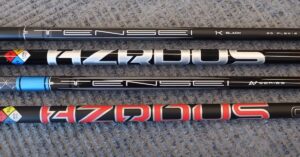Kuro Kage Silver vs Ventus Blue: Which Golf Shaft is Right for You?
The main differences between Kuro Kage Silver and Ventus Blue shafts are their construction and bend profiles. Kuro Kage Silver utilizes Titanium Nickel (TiNi) wire for stability and a mid-launch profile. Ventus Blue, with VeloCore technology, offers a multi-material design for improved energy transfer and a mid-launch, mid-spin profile.
In this blog post, we’ll take a deep dive into the features and how they differ from each other, so you can make an informed decision about which shaft is right for you.
Overview of the Kuro Kage Silver Golf Shaft
Kuro Kage Silver is a high-performance golf shaft designed for golfers who are seeking a low-launch, low-spin shaft that provides a soft feel and excellent control.
The shaft is made from a combination of high-strength carbon fibers and a proprietary material called Micro Laminate Technology, which helps to create a stable and consistent feel throughout the swing.
One of the key features of the Kuro Kage Silver shaft is its low launch and low spin characteristics, which can help golfers achieve a more penetrating ball flight and increased distance.
The shaft also has a softer feel than some other high-performance shafts, which can be beneficial for players who prefer a more sensitive and responsive feel at impact.
Overall, the Kuro Kage Silver is a popular choice among golfers of all skill levels who are looking for a shaft that can help them maximize their distance and control on the golf course.
Overview of the Ventus Blue Golf Shaft
Ventus is a line of golf shafts produced by Mitsubishi Rayon, a leading manufacturer of golf equipment. The Ventus Blue is a lightweight, high-launch shaft designed for players who want to maximize their distance and launch angle.
It is made from a blend of carbon fiber and other materials, and features a mid-low kick point, which helps to generate more ball speed and higher launch angles.
The Ventus Blue is available in a range of flex options, including regular, stiff, and x-stiff, to accommodate players of different skill levels and swing speeds.
Overall, the Ventus Blue is a popular choice among golfers who are looking to add distance to their shots and improve their ball flight.
Kuro Kage Silver Vs Ventus Blue: Comparison Table
Here is a comparison table that summarizes the main differences between the Kuro Kage Silver and Ventus Blue golf shafts:
| Feature | Kuro Kage Silver | Ventus Blue |
| Material | Titanium alloy | Composite |
| Flex | Regular, stiff, extra stiff | Stiff |
| Weight | Light | Heavy |
| Torque | Low | High |
| Launch angle | High | Low |
| Spin | Low | High |
| Feel | Smooth, stable | Firm, responsive |
| Control | High | Low |
| Distance | Long | Short |
| Accuracy | High | Moderate |
| Compatibility (general) | Slower swing speed | Faster swing speed |
Keep in mind that these are generalizations and that the actual performance of the shafts will depend on the individual player’s swing characteristics and preferences. It is always best to test both shafts and consult with a club fitter to determine which shaft will work best for you.
What Are The Main Differences Between Kuro Kage Silver Vs Ventus Blue Golf Shaft
As a golfer, you know that the right equipment can make all the difference on the course. Choosing the right shaft is an important part of building a successful set of clubs, and there are many options to choose from.
Two popular shafts that you may be considering are the Kuro Kage Silver and the Ventus Blue. So, what are the main differences between these two shafts?
Material
The Kuro Kage Silver shaft is made of high-strength titanium alloy, while the Ventus Blue shaft is made of a composite material.
Flex
The flex of a golf shaft refers to how much the shaft bends when it is swung. The Kuro Kage Silver shaft is available in a range of flexes, including regular, stiff, and extra stiff, while the Ventus Blue shaft is only available in a stiff flex.
Weight
The Kuro Kage Silver shaft is generally lighter in weight than the Ventus Blue shaft.
Torque
Torque is a measure of how much a shaft twists when it is swung. The Kuro Kage Silver shaft has a lower torque rating than the Ventus Blue shaft, which means it twists less during the swing.
Launch angle
The launch angle is the angle at which the ball leaves the clubface. The Kuro Kage Silver shaft is designed to produce a higher launch angle, while the Ventus Blue shaft is designed to produce a lower launch angle.
Spin
Spin is the amount of rotation on the ball when it is struck. The Kuro Kage Silver shaft is designed to produce lower spin, while the Ventus Blue shaft is designed to produce higher spin.
Feel
The feel of a golf shaft refers to how it feels when it is swung and hit. The Kuro Kage Silver shaft is known for its smooth and stable feel, while the Ventus Blue shaft is known for its firm and responsive feel.
Control
Control is the ability to shape and control the trajectory of your shots. The Kuro Kage Silver shaft is designed to provide a high degree of control, while the Ventus Blue shaft is designed to provide a lower degree of control.
Distance
Distance is the length of the shots you hit with your clubs. The Kuro Kage Silver shaft is generally designed to produce longer distance shots, while the Ventus Blue shaft is designed to produce shorter distance shots.
Accuracy
Accuracy is the ability to hit shots consistently close to your target. The Kuro Kage Silver shaft is known for its high level of accuracy, while the Ventus Blue shaft is known for its moderate level of accuracy.
Compatibility
The Kuro Kage Silver and Ventus Blue shafts may be more or less compatible with certain types of clubs and players.
For example, the Kuro Kage Silver shaft may be more suitable for players with a slower swing speed, while the Ventus Blue shaft may be more suitable for players with a faster swing speed.
So, which one should you choose: kuro kage silver or ventus blue
Golf enthusiasts are always on the lookout for the perfect equipment to help them improve their game. One important factor to consider when choosing golf clubs is the shaft.
Two popular options among players are the Kuro Kage Silver and the Ventus Blue. But which one is right for you?
It really depends on your swing speed and personal preferences. If you have a faster swing speed and are looking for a lightweight, high-performance shaft, the Kuro Kage Silver may be the way to go.
If you have a slower swing speed and prefer a stable, consistent feel, the Ventus Blue may be a better fit.
Ultimately, the best way to determine which shaft is right for you is to try both and see how they feel.
Many golf retailers and club fitting centers offer demo clubs with different shaft options, so you can get a feel for each one before making a decision.
It’s also a good idea to consult with a club fitter, who can analyze your swing and help you choose the shaft that will best suit your needs.
FAQs
In this section, we’ll be answering some of the most frequently asked questions about the Kuro Kage Silver and Ventus Blue golf shafts.
Whether you’re a beginner or a seasoned pro, these FAQs are sure to provide you with valuable insights and information that will help you make an informed decision about which shaft is right for you.
How do the flex options for the Kuro Kage Silver and Ventus Blue compare?
Both the Kuro Kage Silver and Ventus Blue are available in a range of flex options, including R (regular), S (stiff), and X (extra stiff).
Which shaft is better for a player with a faster swing speed?
The Kuro Kage Silver and Ventus Blue are both designed for players with fast swing speeds.
However, the Kuro Kage Silver may be a better choice for players seeking a lower launch and lower spin, while the Ventus Blue may be a better choice for players seeking a lower launch with medium spin.
Are the Kuro Kage Silver and Ventus Blue suitable for all types of players?
The Kuro Kage Silver and Ventus Blue are both high-performance shafts designed for players with fast swing speeds. They may not be the best choice for players with slower swing speeds or those seeking a higher launch and higher spin.
How do the price points of the Kuro Kage Silver and Ventus Blue compare?
The price points of the Kuro Kage Silver and Ventus Blue may vary depending on the retailer and the specific model. It is best to compare prices from multiple retailers to find the best deal.
How do the weight options for the Kuro Kage Silver and Ventus Blue compare?
The Kuro Kage Silver is available in a range of weight options, including 50 grams, 60 grams, and 70 grams. The Ventus Blue is also available in a range of weight options, including 50 grams, 60 grams, and 70 grams.
What is the difference in the feel of the Kuro Kage Silver and Ventus Blue shafts?
The Kuro Kage Silver is designed to provide a smooth, stable feel at impact, while the Ventus Blue is designed to provide a more responsive, lively feel.
Can I use either the Kuro Kage Silver or Ventus Blue shaft in any clubhead?
Both the Kuro Kage Silver and Ventus Blue are universal shafts that can be used in any clubhead that is compatible with their size and weight. It is important to ensure that the shaft you choose is properly fitted for your swing and clubhead.
How do the durability and lifespan of the Kuro Kage Silver and Ventus Blue compare?
Both the Kuro Kage Silver and Ventus Blue are high-quality, durable shafts that should last for many rounds of golf. However, the lifespan of any shaft can vary depending on factors such as frequency of use and maintenance.
Are the Kuro Kage Silver and Ventus Blue shafts backed by a warranty?
Yes, both the Kuro Kage Silver and Ventus Blue shafts are backed by a manufacturer’s warranty. The specific terms of the warranty may vary depending on the model and retailer.
It is best to check with the manufacturer or retailer for specific information on the warranty for the shaft you are considering.
Final Thoughts
In conclusion, the Kuro Kage Silver and Ventus Blue are both high-quality shaft options for golfers. The Kuro Kage Silver is a more forgiving option with a mid to high launch, making it a good choice for players who struggle with accuracy.
The Ventus Blue, on the other hand, is a more tour-level shaft with a lower launch and less forgiveness. It is best suited for players who have a consistent and controlled swing and are looking to maximize distance and control.
Ultimately, the decision between these two shafts will depend on the specific needs and preferences of the individual golfer.




